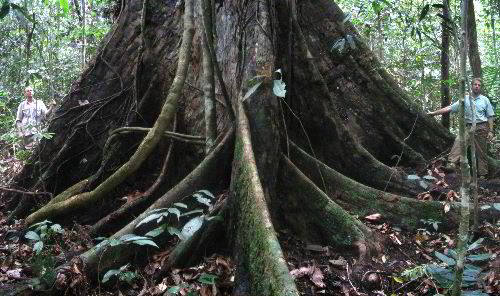
photo (by Brett Mifsud) of the world's tallest documented tropical
tree, "Pokok Gergassi Tawau". It is an 88.1 m Shorea
faguetiana (Dipterocapaceae). Tom Greenwood, Brett Mifsud and
I measured it with a tape drop in Sabah, Malaysia September 2005.
Pictured are James Aldred on the left and Roman Dial on the
right. |
| Borneo
Rucker |
bor-@gci.net |
| Sep
25, 2005 13:16 PDT |
A few years (October 29 and 30, 2002) ago BVP posted a
conjecture that
the Rucker Index for Borneo would make his list of places that
exceed
200 feet.
Well, we now have the data to show that the current Rucker Index
for
Sabah, the Malaysian state of northern Borneo (26,000 sq miles
or so),
is 256.15 feet. This puts Borneo on the short list of places
that exceed
250 feet, above Washington and below Australia (although the
list Bob
posted is likely out of date by now for actual numbers).
We (including Australian big tree hunter Brett Mifsud and
super-climber
Tom Greenwood) were sponsored by National Geographic and so can
not
publicly describe our results just yet.
Of 17 species from 4 families in Sabah that we have measured
using
Impulse 200 LR and tape drop methods, 15 species from 3 families
reach
over 200 feet, and 6 species from 2 families are over 250 feet.
The lowland tropical rain forests where these tall trees grow
are
marvelously diverse. Their climate reminds me of the USA's
eastern
seaboard during midsummer, with similar temperatures, humidity,
but far
more noisy cicadas species and near West-coast sized trees. The
tall
trees of Borneo are all hardwood and so their crowns make for
super
fun climbing as well.
Roman Dial
|
| Imbak
and Tawau |
Roman
Dial |
|
Sep
26, 2005 22:33 PDT |
Bob,
on a recent trip to Borneo I heard of a new conservation
area
called Imbak Canyon Conservation Area in Sabah.
As denizens
of the cool NW, BVP and Steve Sillett are not hot
and humid
weather people, clearly, so I invited the two Australians, Tom
and
Brett, to go to Imbak in search of tall trees. The idea was to
find
really tall trees and encourage more stringent protection of the
Imbak
Conservation Area (which could still be logged), similar to what
happened in the early 1960's when Nat Geo sponsored exploration
of the
area that became Redwoods NP in CA. A noble cause for some good
tree
hunting and climbing.
So we spent a week in Imbak, flying in by helicopter and hiring
porters
to carry our food. A grand adventure....Unfortunately the
tallest trees
in Borneo where not there in Imbak, although the buttreses were
big,
beautiful, and numerous. The rucker Index was 70.7 m or 231.96
feet at
Imbak, pretty good for an area sampled that was 675 hectares.
Indeed all
but the Koompassia ( on most Borneo Ruckers) were found in a 54
hectare
area.
After Imbak we went 100 km east to Tawau to check the reputed
tallest
Koompassia of all, one whose label at its base in the private
palm oil
plantation said 90 m -- alas as everyone who measures tall trees
knows,
the true height was less -- far less, by 8 m.
The tallest trees we found less than 2 km away in Tawau Hill
Park, a
27,000 hectare Sabah State Park that was established in a sea of
oil and
cocao plantations to protect the water supply there. Most of it
has been
selectively logged, but we found a small 1 or 2 hectare patch
with 5
trees of four different species that each reached over 80 m. We
think
there is a 90 m tree in there and **know** there's one very
close to
that:)
Anyway 70-80 m Koompassias are quite common in the surrounding
palm oil
plantations, standing as giant, white ghosts of the former glory
of
Dipterocarp lowland tropical rainforests there. They were spared
the saw
becasue their high silica content dulls milling blades, they are
a
favorite nesting site of the giant Asian honey bee (Apis dorsata,
who
nests there because Malaysian sun bears and other climbing
bee-eaters
can't climb the smooth, hard bark, although people pound pegs
into the
trunk and climb rattan ladders to collect honey), and the locals
feel
that Koompassia trees are favored haunts of forest spirits.
Tawau has very tall trees and is known to historically have had
the
tallest trees due to the basalt soils there, which are very rare
for
Borneo. These soils make Tawau the richest palm oil producing
region in
Sabah, the state which is the richest oil palm producer in
Malaysia,
which is apparently the best oil palm producing country in the
world.
The main nuisance, however, are the very active land leeches.
Even now,
week-old bites itch, my socks are blood stained, and I can feel
the
disgust of discovery as red blood pours down my leg.
Roman
|
| RE:
Borneo Rucker |
Robert
Leverett |
| Sep
26, 2005 09:01 PDT |
Roman,
Can we ask you to give us a little
biograophical sketch of yourself?
We're absolutely blown over by your report and honored that you
have
shared the Rucker information on Borneo with us. Where all do
you go to
study/climb/measure great trees? Please tell us.
In this era of planetary forest shrinkage,
areas such as you identify
are true treasures. Their inaccessibility to the general public,
plus
the technical difficulties of getting accurate tree dimension
data on
them, puts these tropical forest gems in a class all by
themselves. I
can only visualize the size of the insects, spiders, and snakes
that you
must come across. Wow! My hat is off to you.
Bob
|
|